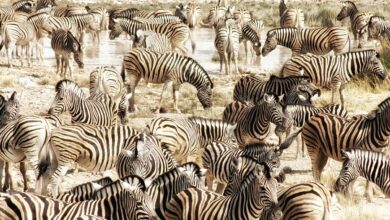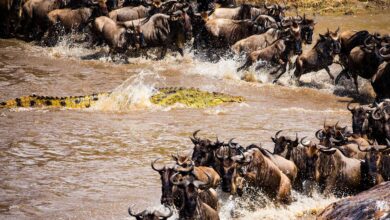
- Leopards are very secretive and territorial in their behavior
- Black Leopards
Leopards are mysterious and elusive creatures, known for their stealth and adaptability. Whether you’re marveling at their climbing prowess or their distinctive rosettes, these big cats are some of the most fascinating animals on the planet.
Though sightings are rare in places like Mount Kilimanjaro, leopards remain an integral part of wildlife history, with tales of frozen leopards atop the mountain still captivating explorers today.
Here, we dive into 10 amazing facts about leopards, from their habitat to their unique hunting strategies.
1. Leopard Spots: Why They’re Called Rosettes
The characteristic dark spots on a leopard’s coat are called “rosettes” because they resemble the shape of a rose. These spots provide excellent camouflage, allowing leopards to blend seamlessly into their surroundings.
Interestingly, melanistic leopards, commonly referred to as black panthers, still have rosettes, but they are difficult to see due to the leopard’s dark coat.
2. Leopards: Masters of Climbing and Tree Life
Leopards are strong climbers and are often seen lounging on tree branches, particularly during the day. These agile cats also drag their prey up into trees to protect it from scavengers like hyenas and lions.
Their muscular build and retractable claws make them excellent at climbing, allowing them to hoist heavy prey high into the branches.
3. The Smallest of the Big Cats: Leopards vs. Tigers and Lions
Though they are one of the most powerful predators, leopards are the smallest members of the big cat family, which includes lions, tigers, and jaguars.
Female leopards weigh between 46 and 132 pounds, while males can weigh up to 165 pounds. Despite their size, leopards have no trouble bringing down much larger prey due to their strength and agility.
4. How Fast Can Leopards Run? Speed and Agility in the Wild
Leopards are known for their remarkable speed, able to reach 36 miles per hour when chasing prey. This agility also extends to their ability to leap 20 feet in a single bound and jump up to 10 feet vertically. While they aren’t as fast as cheetahs, their speed and stealth make them highly effective hunters.
5. Leopards’ Global Range: Where They Live
Leopards are found across a wide range of habitats, from the savannas of sub-Saharan Africa to the forests of India and China.
They are incredibly adaptable and thrive in diverse environments such as rainforests, mountains, and deserts. Sadly, many leopard subspecies, like the critically endangered Amur leopard in Russia, face severe population threats due to habitat loss and poaching .
6. The Solitary Lives of Leopards: Social and Territorial Behavior
Leopards are solitary animals that spend most of their lives alone, marking their territory with urine, feces, and scratch marks on trees.
Male and female leopards typically only meet for mating, and males are not involved in raising the cubs. Once the cubs are born, the female takes sole responsibility for their upbringing until they are old enough to hunt on their own.
7. What Do Leopards Eat? Understanding Their Opportunistic Diet
Leopards are opportunistic hunters and have one of the broadest diets among big cats. They will prey on a wide variety of animals, from small creatures like birds and reptiles to larger mammals like antelopes and gazelles.
This varied diet has allowed leopards to thrive in areas where other big cats have struggled. When food is scarce, leopards will even hunt smaller and more abundant prey .
8. How Do Leopards Hunt? Ambush Predators in Action
Leopards rely on stealth and patience to hunt their prey, often ambushing them at night when their vision is seven times better than a human’s.
Their rosettes act as perfect camouflage among leaves and grass. Once within striking distance, they pounce, delivering a powerful bite to the throat or a swipe with their muscular paws for smaller prey.
9. How Leopards Communicate: Roars, Chuffs, and More
Unlike lions, leopards do not roar. Instead, they use a variety of vocalizations to communicate, including a distinctive rasping bark that can be heard up to two miles away. Leopards also chuff—a friendly greeting sound—and purr like domestic cats when content. When angry, leopards growl, warning others to stay away.
10. Leopard Cubs: Short Gestation and Maternal Care
Leopard cubs are born after a short gestation period of around three months, typically in litters of two or three.
The cubs are born blind and rely on their mother for protection and nourishment. The short gestation period allows the female leopard to stay agile and continue hunting. Cubs remain with their mothers until they are about two years old .
Quick Leopard Facts:
- Scientific Name: Panthera pardus
- Common Name: Leopard
- Size: 22–22 inches tall, 35–75 inches long
- Weight: 82–200 pounds
- Lifespan: 21–23 years
- Diet: Carnivore
- Habitat: Africa, Asia
- Conservation Status: Endangered or Near Threatened, depending on region
References:
- WWF: Leopard Conservation
- National Geographic: Leopards
- IUCN Red List: Panthera pardus
- Smithsonian National Zoo: Leopards





